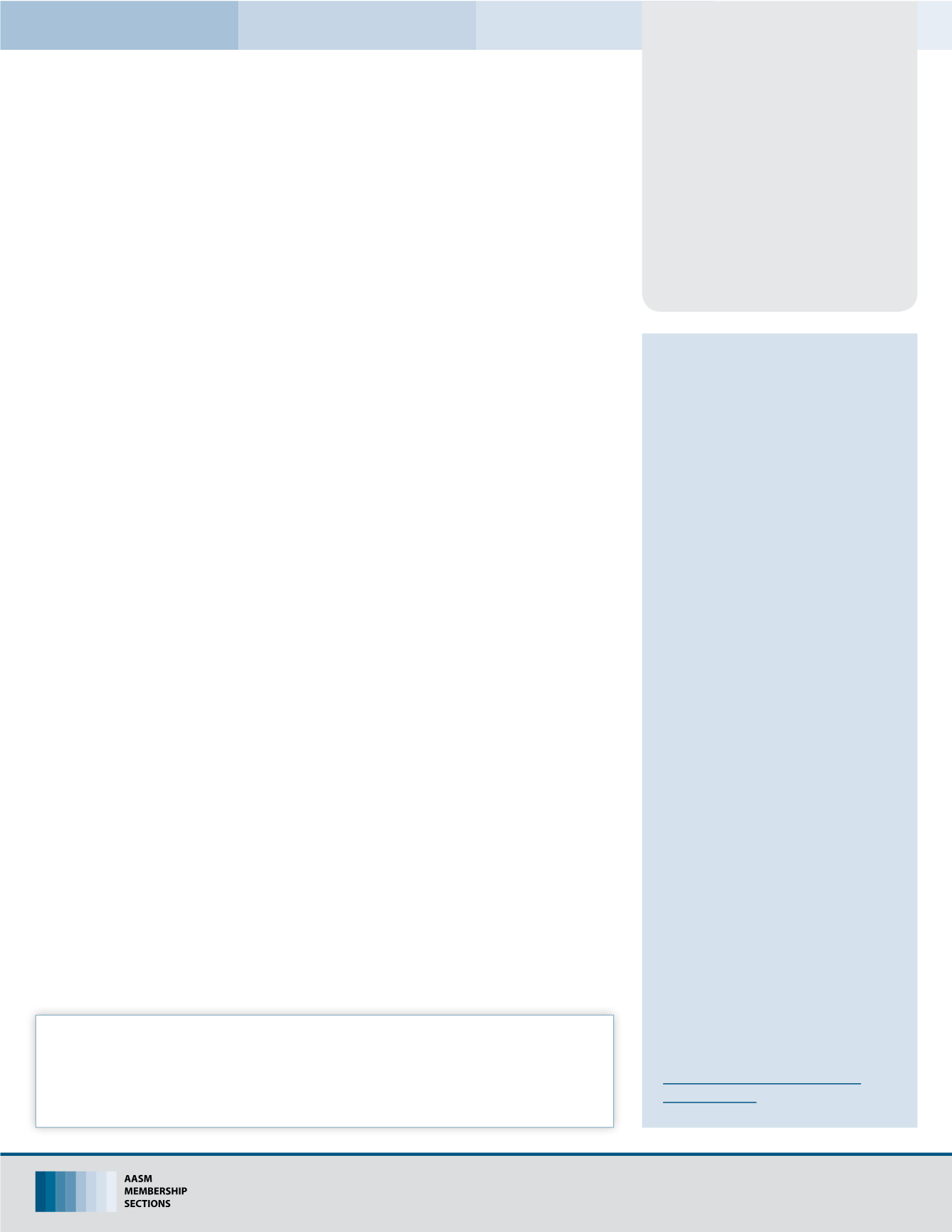
27
AASM Membership Sections Newsletter
■
Issue #6
Sleep Related Breathing
Disorders
Steering Committee
Profiles
Christine Won, MD, MS
(Chair)
Dr. Christine Won, MD, MS,
Chair,
is the Director of the Yale Sleep
Center and Director of Yale’s
Women’s Initiative in Sleep Health
(WISH). She is an active member of
the AASM, having recently served
three years on the AASM Education
Committee and on the CPAP
Adherence Education Task Force
in 2010. She is active in the local
sleep community, serving on the
Board of Directors of the Connecticut
Sleep Society. She is an Assistant
Professor of Medicine in the section
of Pulmonary, Critical Care and Sleep
Medicine at Yale University, and the
Associate Program Director for the
Yale Pulmonary and Critical Care
fellowship program. Prior to this she
was an Assistant Professor in the
section of Pulmonary and Critical
Care at UCSF, and served as their
Associate Director for the Sleep
program. She completed her sleep,
pulmonary and critical care training
and undergraduate education at
Stanford University.
Katie Sarmiento, MD
(Vice Chair)
Dr. Kathleen Sarmiento, MD,
Vice-
Chair
, is the Director of Pulmonary
Sleep Medicine at the VA San Diego
Healthcare System and an Assistant
Professor at the University of
2014 – 2015
CHAIR
Christine Won, MD, MS
VICE-CHAIR
Katie Sarmiento, MD
MEMBERS
Chad Hagen, MD
John Park, MD
The Final Frontier of Apnea Testing
By Dr. Chad Hagen, MD
I remember Dr. McCoy on Star Trek waving a gadget over a fallen crew member then
declaring the patient’s medical status. As a young boy I couldn’t wait for this technology to
come to market and save me from future injections and blood draws. To my disappointment,
decades have passed and we’re still subjected to hypodermic needles! However, minimally
invasive and even non-contact sensors are emerging throughout medicine. Transcutaneous
devices can now measure blood gases, glucose, bilirubin and hematocrit. Non-contact
sensors can measure body temperature, intraocular pressure, periodic limb movements,
heart rate and respiratory rate. More recently, emerging technologies venture into the new
frontier of non-contact apnea detection and sleep measurement inferred from non-contact
movement detection.
Non-contact sensors for the detection of sleep apnea began in the 1980s with the static
charge sensitive bed (SCSB).
1
The SCSB consisted of two bed sized metal plates, separated by
an insulator, all placed underneath a typical foam mattress. The device showed promise for
the detection of frank obstructive apneas with a sensitivity of 92 to 98%. Hypopnea proved
more difficult to distinguish, but potential for use as a screening device was established.
In Japan, a sheet-like device called SD-101 has been validated and is used clinically. SD-
101 contains 162 pressure-sensitive sensors to identify breathing and sleep apnea in both
adults and children.
2,3
The sheet of sensors is placed on a bed to measure change in mass
distribution from respiration and apnea. The respiratory disturbance index (RDI) detected
by SD-101 combined with oximetry correlates highly with apnea-hypopnea index (AHI)
by standard polysomnography (PSG) (r = 0.965, p < 0.0001). SD-101’s good sensitivity
improves further from 88% to 97% and specificity improves from 86% to 91% when used in
conjunction with oximetry. This device is currently in practice, helping improve comfort,
sleep and access to disease detection in Japan.
Our multidisciplinary sleep and biomedical engineering group at Oregon Health and
Science University has demonstrated detection of sleep apnea, movement, lying position
and periodic limb movements with a non-contact force sensor integrated into the frame
or supports of a bed. In one study, we repeated PSG scoring with a blinded scorer after
removing nasal pressure, thermistor, chest belt and abdomen belt signals and replacing
them with signals from non-contact force sensors. The AHI scored with these force
sensors was highly correlated with standard obtrusive sensors (R2 = 0.94) and sensitive
DISCLAIMER
No part of this publication may be reproduced without the permission of the American Academy of Sleep Medicine
(AASM). The statements and opinions contained in editorials and articles in this newsletter are solely those of the authors
and not of the AASM or of its officers, members or employees. The Editor and Managing Editor of the Membership
Sections Newsletter, the AASM and its officers, members and employees disclaim all responsibility for any injury to
persons or property resulting from any ideas, products or services referred to in articles in this publication.


